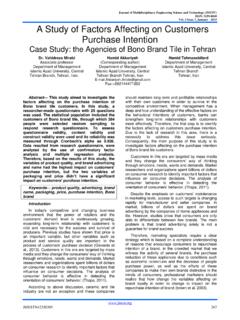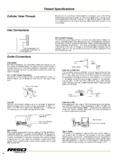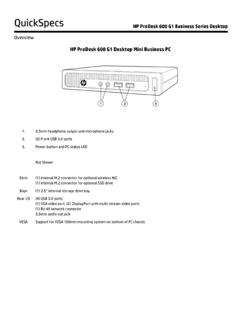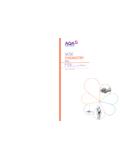Transcription of Load and stress distribution in screw threads with ...
1 Journal of Multidisciplinary Engineering Science and Technology (JMEST). ISSN: 2458-9403. Vol. 4 Issue 1, January - 2017. load and stress distribution in screw threads with modified washers Carlo Brutti Dept. of Enterprise Engineering University of Rome Tor Vergata Rome, Italy Abstract This paper reports the study of the I. INTRODUCTION. effects of washer on the strength of bolt-nut All industrial applications commonly use threaded connections. We developed a complete theoretical joints as, for example, in petroleum, transport, mining, calculation procedure, modifying the classical automotive, offshore industry and in manufacturing Maduschka's approach, to determine the load process and more recently in dental implants.
2 The distribution and then we proposed an assembly of structural behavior of threaded joints is a classic topic in different results, available in bibliography, to mechanical design. The oldest scientific papers evaluate the stress state at the first thread . FE [1][2][3][4] date from the first half of 20th century; they models, properly developed, showed a good focused correctly the main problems: the not uniform agreement with theoretical results. In this way, it load distribution on the engaged threads , the stress was also possible to study how the maximum load concentration at the root of the threads and under the and stress reduce by enlarging the internal head of the screw .
3 As reported in [5], failures in screws diameter of the washer, so enhancing the strength can be divided: 15% at the fillet under the head, 20% at and fatigue life by means of a simple and not the first thread and 65% at the first engaged thread . The expensive modification. The improving effect is industrial applications use different types of threaded more effective on the largest size of threaded connections as bolt-nut, threaded piping connection, tie connection among those examined. rod connection, shear loaded bolted joint; they are loaded differently and exhibit various problems Keywords screw thread ; load distribution ; regarding the structural behavior.
4 This paper refers to stress evaluation; Washer the case of bolt and nut equipped by first problem to solve is the calculation of load distribution Nomenclature along the engaged threads . In their interesting historical 2 Angle of the thread ( ) review on this problem, Strizhak and Penkov [6] affirm Dm*=2rL Medium diameter of the bolt and nut (mm) that probably the first scientifically well-stated method is Dmn = 2rmn Medium diameter of nut (mm) due Joukovsky, that treated the problem as a discrete, Dw = 2rw Washer diameter; i internal, e external statically indeterminate case and concluded that the De = 2rext External diameter of the nut (mm) load distribution follows a decreasing geometrical Dint = 2rroot Diameter of root of thread (mm) progression.
5 The Joukovsky solution, originally l Pitch of the threads (mm) published in 1902, did not get a general notoriety n Number of threads engaged because the original work was only in Russian. More Flexibility of thread (mm/N); T thread , WN known is the paper by Den Hartog [2] where he stated that the mating pitches vary, due to the tension of bolt Nut + Washer and compression of nut and so this produces a not E,G, Young, Shear modulus (MPa) and Poisson uniform load distribution along the threads . In 1936. coefficient Maduschka [7] developed another discrete method f Friction factor where the threads are regarded as independent circular F Axial force (N) collars and the contact condition between them requires Fo Radial load on the first thread , = F tg that the pitch variation due to the external load is equal Fi Force in the ith- thread (N) in bolt and nut.
6 Using the theory of equation in finite qi Axial load on the ith- thread (N/mm) differences, Maduschka obtained a closed form i distribution coeff. of the ith- thread Fi/(F/n) solution. All the methods above cited base on a discrete u Radial displacement (mm) model of the threaded joint but the real features of the w Axial displacement (mm) joint are, on the contrary, continuous. The first analytical z r Strain components according to z, r continuous solution is due to Birger. In his paper, (cylindrical reference system) dated 1944 [8], the axial load is distributed according to A* Equivalent bolt cross section (mm ) hyperbolic cosine.
7 Few years later, Sopwith [9]. introduced a differential equation that takes into account = Dm*2/4 the continuous variation of the contact condition and A Equivalent nut cross section (mm ) consequently the strain field. In the same paper, he = De2-Dm*2)/4 examined the methods for improving the strength of the H Radial length of the thread (mm) threads trough the optimization of the shape. HN Total height of the nut (mm). JMESTN42352017 6523. Journal of Multidisciplinary Engineering Science and Technology (JMEST). ISSN: 2458-9403. Vol. 4 Issue 1, January - 2017. After these classical papers, some modification were In the last decades, experimental, theoretical and proposed by other researchers as Miller et al.
8 [10], numerical investigations treated the fatigue strength Kenny e Patterson [11], Zhao [12], to take into account evaluation. We can distinguish three main issues. The various specific effects. Another numerical contribution first regards measuring experimentally the fatigue is due, more recently, to Mohiuddin et al. [13] that strength from a general point of view [40], [41], taking applied the method of the potential-displacement to the into account the effect of thread modification and determination of the load distribution . Wang and examining particular loading conditions and different Marshek [14] devoted their attention to the problem of methods to evaluate the fatigue life [42][43][44][45].
9 Elastic-plastic behavior of the threads . Many researchers focused their attention to an experimental The second issue is to apply the Fracture Mechanics confirmation of the various theoretical methods. For to the strength of threaded connection through the example Brutti and D'eramo [15], using the classical calculation of SIF [49], [50], [51], [52] and [53] or through photoelastic results obtained by Hetenyi [4], showed the calculation of the collapse number of cycles [54], that both the methods of Maduschka and Sopwith give [55], [56] and [57], evaluating the crack growth. The reliable results.
10 Sopwith's theory for the thread load third topic regards the theoretical and numerical distribution was validated by several studies; among evaluation of fatigue life by means of local approach them, Kenny and Patterson [16] used frozen stress [43][45] or using the available damage models for photoelastic method in full-scale models of 30 mm ISO fatigue assessing . nuts and bolts, obtaining good agreement with theory. In this paper, we investigated how load distribution D'Eramo and Cappa [17] too obtained a good and maximum stress change inserting a washer under agreement between theoretical and experimental the nut and enlarging the internal diameter.














